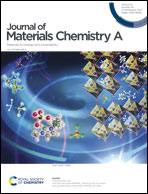Realizing high energy density and efficiency simultaneously in (Bi0.5Na0.5)0.7Sr0.3TiO3-based ceramics via introducing linear dielectric CaTiO3†
Abstract
Modern electronics and electrical power systems require a high energy storage density (Wrec) and a large efficiency (η) to deliver high performances. Although dielectric capacitors have been extensively explored owing to their numerous advantages, it is still a great challenge to develop dielectric materials with excellent comprehensive energy storage performances. Herein, we demonstrate that an ultrahigh Wrec of 7.0 J cm−3 and a large η of 90.9% are obtained simultaneously in 0.60(Bi0.5Na0.5)0.7Sr0.3TiO3-0.40CaTiO3 ceramics by the synergistic contribution of delayed low-field polarization saturation and improved breakdown strength (Eb). The composition-driven fine domain size delays low-field polarization saturation and enhances η, which are confirmed by experimental characterization [high-resolution transmission electron microscopy (HR-TEM) and piezoresponse force microscopy (PFM)] and analysis using multiple models (V–F model, macroscopic and phenomenological model, and conceptual model based on the Landau–Devonshire theory). Phase-field simulations confirm that the fine grain size contributes to the enhancements of Eb. This contribution provides a feasible paradigm for designing dielectric materials exhibiting high energy storage performances and reveals fundamental insights into the origin of delayed polarization saturation and high Eb.



 Please wait while we load your content...
Please wait while we load your content...